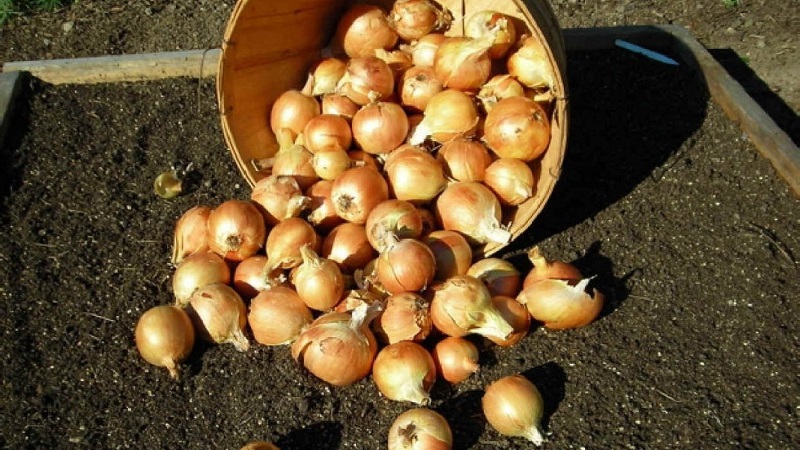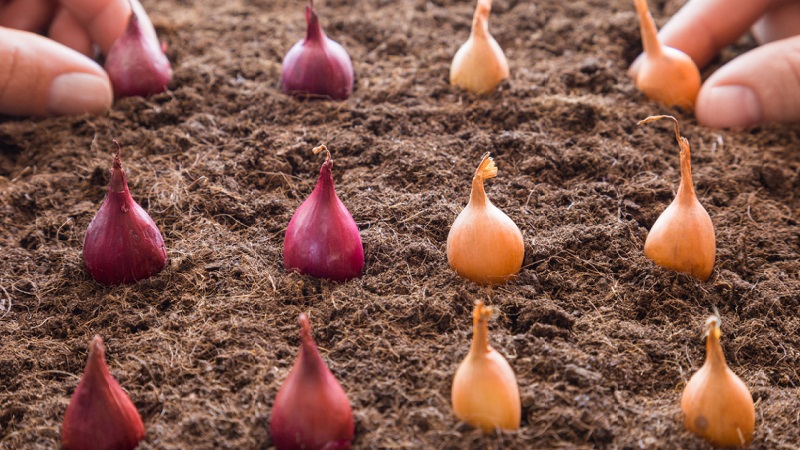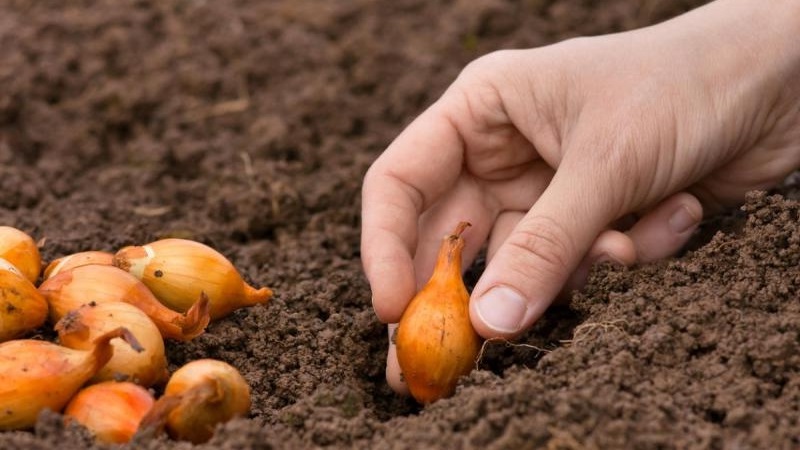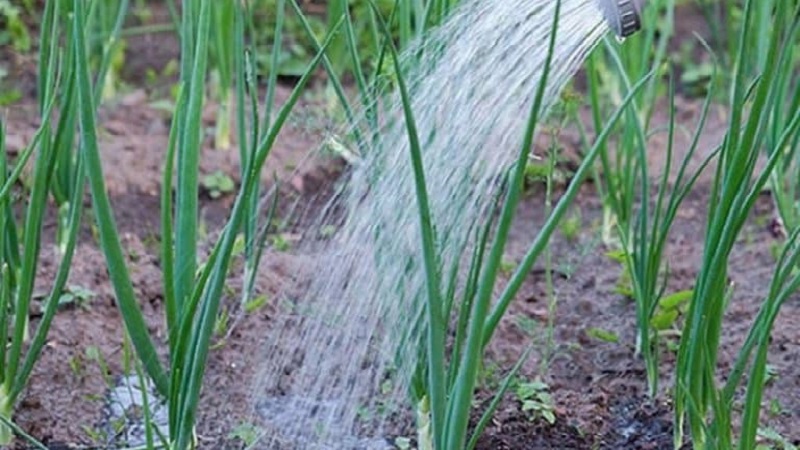Technology of planting onions before winter: at what depth and distance from each other to plant
Due to its numerous useful properties, unique aroma and taste, onions are popular among owners of vegetable gardens and summer cottages. It is planted not only in spring, but also before winter. This landing method has its own characteristics and advantages.
The content of the article
- Advantages and disadvantages of planting onions before winter
- Winter onion varieties
- Choosing a landing site
- Preparation of planting material
- Soil preparation
- Scheme and rules for planting before winter
- Features of growing and care
- Do I need to cover plantings for the winter
- What problems can arise when growing
- Tips and tricks from experienced gardeners
- Conclusion
Advantages and disadvantages of planting onions before winter
The main advantage of this planting method is the ability to get early greens next year. The crop is harvested almost a month earlier than it is done with spring planting.

Oatmeal is used as seed - bulbs less than 1 cm in diameter... Such a set is cheap, does not go into the arrow and grows into a full-fledged turnip, which is well stored.
It should be noted and other advantages of planting winter onions:
- The natural conditions of winter harden the plants, so they become more resilient and rarely get sick.
- Due to the early emergence of seedlings in spring, the crop is less affected by pests. During this period, many insects are still absent.
- Onions do not overgrow with weeds so quickly, as they develop faster.
- In early spring, there is a large amount of moisture in the soil, which is needed in order for full-fledged bulbs to form.
This method also has disadvantages.... One of them is the inability to plant large seed material (more than 2 cm). It is not possible to get a turnip from it, since the bow goes to the arrow. Therefore, you can only use large bulbs for growing greenery.
Other disadvantages:
- Lower germination.
- Difficulty in determining the optimal time for planting seed due to the difference in climatic conditions. Bulbs that do not have time to take root die in frost.
Winter onion varieties
Suitable for winter planting yellow and red varieties... Planting material is chosen taking into account the weather conditions in which it will grow.
Most popular with gardeners:
- Black Prince... Mid-season variety. It has dark purple flesh and a semi-sharp taste.
- Robin... Suitable for cultivation in the southern regions. The bulbs are red. They yield good yields and tolerate drought easily.
- Luhansk... Ripens late. Flat bulbs have a pungent taste.
- Buran... Variety with an average yield and a yellow-brown turnip. Suitable for different climatic zones.
- Radar... Dutch variety with high resistance to diseases and pests. Yields large bulbs weighing 200-300 g.

Choosing a landing site
Choose an area that is well lit and protected from the wind... If you plant a seed in a shaded place, the green mass of the plants will intensively grow, and the formation of bulbs will be delayed.
Attention! It is important to choose a bed where water does not stagnate. If the soil is waterlogged, the bulbs will get wet and rot.
Preparation of planting material
For planting in the winter, take a set of about 1-2 cm in size... To obtain early greens, use larger seed material.
Important! Only healthy seeds are selected without damage and traces of disease.
For two weeks before planting, the sets are placed into water with a temperature of about 50 ° C for 2-3 hours... Then the bulbs are pickled. For this, the following means are used:
- "Tiram";
- Fitosporin-M;
- "Maxim".
You should hold the oatmeal in the solution for half an hour.
For the purpose of prevention, it is recommended soak the bulbs in a strong solution of potassium permanganate for an hour, and then dry.
Soil preparation
They begin to prepare the site 10-14 days before planting the bulbs.... The soil with a dense structure is dug up onto 1-1.5 shovel bayonets. When preparing light soil, do not loosen so deeply, as the plantings may not emerge.
Vegetable crop likes fertilized neutral or slightly alkaline soil... If the soil is acidic, add lime.
Important! When planting, do not use fresh manure.
1 m2 area apply 20 g of superphosphate and the same amount of potassium chloride. If wood ash is added, potash feeding is abandoned.
If the bed is heavy, clayey and dense soil, add sand - 1-1.5 buckets per 1 m2.

Predecessors
Choosing a place for a bow you need to consider what cultures grew on site in the previous year.
Sevok is planted after:
- cereals;
- cucumbers;
- tomatoes;
- cabbage;
- melons;
- watermelons.
For vegetable crops also suitable areas where green manure used to grow.
It is not recommended to plant onions in the area where they were grown:
- potatoes;
- parsley;
- alfalfa;
- celery;
- beans.
Scheme and rules for planting before winter
When planting seed, you should adhere to recommended landing patterns for maximum germination and development of large bulbs.
At what distance from each other to plant onions before winter
The planting scheme is chosen depending on the purpose of the crop.... To obtain a turnip, the distance between the bulbs during planting is left about 10 cm, and between the rows - 20 cm.

If the vegetable crop is grown for greenspracticing a tight fit. Leave 2-3 cm between the bulbs and make a row spacing of about 10 cm.
How deep to plant onions
Oat placed at a depth of 3-4 cm.
Landing technology
Planted as follows:
- The soil is loosened and leveled with a rake.
- A groove is made about 6 cm deep.
- Add sand (2 cm). It will act as a drainage system, removing excess water and preventing the seedlings from getting wet.
- Spread out oatmeal, sprinkle with earth and lightly tamp.
Planted bow do not water for 10-14 days.
What happens if you don't keep the distance
The wrong pattern and the distance between onion plantings in the fall will lead to a decrease in yields. vegetable culture. If you plant the onion deeply, it may not sprout in the spring. In the case of shallow planting, the seedlings will be on the surface and, when the soil settles, they will freeze in winter.
Features of growing and care
In spring, winter onions rise early, as soon as the sun warms up... Small frosts are not afraid of him. At lower temperatures, damage to plants is possible, as a result of which the leaves become white-yellow. In this case, potash or calcium nitrate is used, which promote the regrowth of young greenery and reduce stress in the plant culture.
Loosening and thinning
When growing winter onions, weeds are promptly removed and loosened the ground to a depth of 4-5 cm.The vegetable crop is thinned out after the formation of 3-4 leaves, leaving 5-6 cm between the bulbs.
Attention! Thinning should be done in a timely manner. Failure to comply with the recommended terms leads to a decrease in yield.
Top dressing
In the first half of spring, winter onions are fertilized with a nitrogen composition. As soon as the frost passes, they are introduced into the soil:
- infusion of weeds;
- humates;
- carbamates.
Two weeks later, they are fed with potassium-phosphorus fertilizer - 1 tbsp. l. for 1 bucket of water - or infusion of wood ash. Fertilizers are not used in fertile soil.
Reference. It is also not recommended to use manure during this period.The nitrogen contained in it promotes the formation of feathers and prevents the formation of bulbs.
Watering
Culture needs moderate soil moisture. In the hot period, watered 1-2 times a week, the rest of the time - 1 time in 10 days... In a rainy summer, you can do without watering.

Protection from pests and diseases
During the growing season, onions can infect:
- cervical rot - when damaged, tissues resemble a baked onion;
- black mold - the upper juicy scales of the onion dry out, a black dusty mass forms between them;
- green rot - present at the bottom of the bulb in the form of a brown spot, later a greenish or bluish bloom in the form of mold appears.
Development of fungal diseases is possible:
- downy mildew - the defeat occurs in warm, wet weather, the tips of the feather turn yellow and spots of pale green or grayish-purple appear;
- rust - rusty-yellow strokes appear on the leaves, then the greens dries up;
- fusarium - the root system of the plant is affected, the roots acquire a pinkish tint and die off, the leaves dry.
In case of development of a fungal disease onions planted on a feather cannot be treated with chemical compounds.
When caring for a turnip, fight with diseases comes down to therapeutic and prophylactic measures:
- Before planting seeds, the soil is treated with copper sulfate - 30 g per 10 liters of water.
- In early spring, during the emergence of shoots, Bordeaux liquid is used. The procedure is repeated when the feather grows 10-12 cm.
Preparations will help to reliably protect onions from diseases:
- Fitosporin-M;
- "Glyocladin";
- "Alirin";
- "Gamair".
By these means process vegetable crops 3-4 times during the growing season.
Onion pests:
- onion moth;
- root mite;
- stem nematode;
- tobacco onion thrips;
- onion fly.
Insects settle on the leaves and penetrate the bulbs, suck the juice from the green stems and gnaw the pulp from the turnip. To protect plants from pests, carry out the same activities as for the prevention of diseases. Biologics of systemic action are used, for example, "Bicol".
After processing with such means, onions can be used for food after 48 hours..

Do I need to cover plantings for the winter
To protect the bulbs, cover the soil with mulch 2-3 weeks after planting.
Used as mulch:
- peat;
- fallen leaves;
- straw;
- hay;
- spruce branches;
- branches.
In the northern regions, the thickness of the protective layer is increased.
Important! Do not put plastic wrap on top, as air does not pass through it. The resulting condensation causes the bulbs to rot and freeze.
What problems can arise when growing
When growing winter onions, problems associated with a lack of nitrogen fertilization immediately after emergence in spring.
In a vegetable crop planted before winter, whitening of feather tips and yellowing of greens may be observed... The reasons for this are not only frost and a lack of nitrogen compounds in the first growing season, but also other factors:
- deficiency of potassium and copper;
- acidity of the soil.
Tips and tricks from experienced gardeners
Experienced gardeners when growing winter onions are advised:
- use only small and dry seedlings as planting material;
- choose the right variety, taking into account weather conditions;
- in the middle lane, plant seeds in the period from 5 to 20 October;
- cover the garden bed before winter.
Conclusion
Each owner of a garden or a summer cottage seeks to get a large harvest of bulbs in order to provide himself with vegetables for the year ahead. Therefore, preference should be given to the winter planting option, which has more advantages in comparison with the spring method. With the right approach, it will be possible to avoid diseases and rotting of the vegetable and harvest a healthy crop.